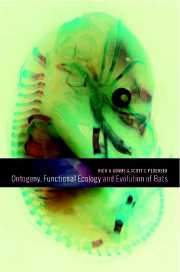Book contents
- Frontmatter
- Contents
- List of contributors
- 1 Integrating ontogeny into ecological and evolutionary investigations
- 2 Bat phylogeny: an evolutionary context for comparative studies
- 3 Early embryology, fetal membranes, and placentation
- 4 Brain ontogeny and ecomorphology in bats
- 5 Evolutionary plasticity and ontogeny of the bat cochlea
- 6 Skull growth and the acoustical axis of the head in bats
- 7 Ontogeny of the chiropteran basicranium, with reference to the Indian false vampire bat, Megaderma lyra
- 8 A theoretical consideration of dental morphology, ontogeny, and evolution in bats
- 9 Wing ontogeny, shifting niche dimensions, and adaptive landscapes
- 10 Ontogeny and evolution of the hindlimb and calcar: assessing phylogenetic trends
- 11 A comparative perspective on the ontogeny of flight muscles in bats
- 12 The ontogeny of behavior in bats: a functional perspective
- Index
9 - Wing ontogeny, shifting niche dimensions, and adaptive landscapes
Published online by Cambridge University Press: 17 August 2009
- Frontmatter
- Contents
- List of contributors
- 1 Integrating ontogeny into ecological and evolutionary investigations
- 2 Bat phylogeny: an evolutionary context for comparative studies
- 3 Early embryology, fetal membranes, and placentation
- 4 Brain ontogeny and ecomorphology in bats
- 5 Evolutionary plasticity and ontogeny of the bat cochlea
- 6 Skull growth and the acoustical axis of the head in bats
- 7 Ontogeny of the chiropteran basicranium, with reference to the Indian false vampire bat, Megaderma lyra
- 8 A theoretical consideration of dental morphology, ontogeny, and evolution in bats
- 9 Wing ontogeny, shifting niche dimensions, and adaptive landscapes
- 10 Ontogeny and evolution of the hindlimb and calcar: assessing phylogenetic trends
- 11 A comparative perspective on the ontogeny of flight muscles in bats
- 12 The ontogeny of behavior in bats: a functional perspective
- Index
Summary
INTRODUCTION
Growth and development of wings in bats is a unique morphogenetic process in mammals. Divergence from a ‘standard issue’ (ancestral) handplate to that of a handwing occurs early in skeletogenesis (Joller 1977; Adams 1992a, b; Raff 1996), and because bats begin flight on immature wings (Jones 1967; Davis 1969; Kunz 1974; Buchler 1980; Kunz & Anthony 1982; Hughes et al. 1987, 1995; Powers et al. 1991; Adams 1996, 1997, 1998; Stern et al. 1997; Hoying & Kunz 1998; Kunz & Hood in press), juveniles face energetic and functional demands confronted by few other mammals. Indeed, the aerodynamic constraints of flight are stringent for juveniles, and although lactating females provide some nutritional security for their newly volant young, this reservoir of nourishment is short-lived (Altringham 1996). In fact, juveniles of insectivorous bat species are weaned typically within two weeks of first volancy (Tuttle & Stevenson 1982; Kunz 1987) and, therefore, the capacity not only for sustained flight, but also maneuverability for pursuing and capturing evasive insects, must develop quickly. Significant changes in wing size during growth produces differential flight abilities that correlate with age (Powers et al. 1991) and foraging juveniles manifesting differing flight abilities affect population and community ecology (Adams 1996, 1997). In this chapter I describe pre- and postnatal limb morphogenesis in several bat species across suborders, and compare their developmental patterns with that of Sorex vagrans, S. cinereus, Rattus norvegicus, Mus musculus, and Acomys cahirinus in order to elucidate developmental shifts responsible in manifesting a handwing. I also contrast limb growth among bats species and compare adult morphologies encompassing seven families across the two suborders.
- Type
- Chapter
- Information
- Ontogeny, Functional Ecology, and Evolution of Bats , pp. 275 - 315Publisher: Cambridge University PressPrint publication year: 2000
- 10
- Cited by



